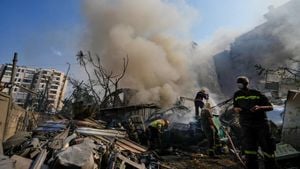Residents across New Mexico are grappling with significant power outages as the state faced one of its most brutal winter storms of the season. Over 50,000 people were left without electricity as strong winds and heavy snow wreaked havoc on power lines and infrastructure. The storm, coupled with dropping temperatures, has led many communities to scramble for basic necessities such as heat and food.
Utility companies, including Public Service Company of New Mexico (PNM) and El Paso Electric, have mobilized crews to restore power, but some areas could remain without electricity for days due to extensive damages. PNM reported multiple power lines downed across the state, leading to widespread disruption. Crews have been working around the clock but are confronting challenging conditions, including icy roads and continued snowfall.
The situation prompted local authorities to issue emergency declarations to facilitate rapid repair efforts and to coordinate responses among various agencies. Governor Michelle Lujan Grisham urged residents to prepare for the worst, advising families to stock up on essentials and to check on neighbors, especially the elderly and those with health issues. She emphasized, “It’s important for everyone to stay warm and safe during this severe weather. We’re working hard to restore power, but these conditions make it difficult.”
Shoveling snow became another task residents couldn’t ignore; with the snowfall accumulating rapidly, many were faced with the challenge of keeping their driveways and sidewalks clear. Local communities organized snow removal volunteers to assist those unable to do so themselves. Neighbors turned to help each other, embodying the spirit of community solidarity during times of crisis.
Reports indicated some areas received over 18 inches of snow, significantly disrupting travel across the state. Major highways were closed temporarily due to whiteout conditions and risk of accidents. The New Mexico Department of Transportation worked diligently to clear roads, but safety remained the priority. Many travelers found themselves stranded or delayed, with some needing assistance from emergency services.
While power outages were critically affecting urban areas like Albuquerque and Santa Fe, rural communities experienced even more pronounced challenges. Some residents reported they remained without power since the storm's onset, leaving them reliant on generators or alternative heating methods. Fuel availability became another concern, as demand spiked, and supply chains struggled to keep up.
First responders have remained vigilant, ready to assist those affected, especially the most vulnerable populations. Emergency shelters were opened to provide warm refuge for those displaced from their homes due to outages or severe weather. Local organizations stepped up to provide food, blankets, and medical supplies at these shelters, acknowledging the immediate needs of the community.
The storm’s aftermath sees fears of potential flooding as temperatures are expected to rise following the frigid spell, creating conditions for ice melt. This added concern of flooding will require additional preparedness as communities transition from winter conditions to potentially hazardous spring weather.
Experts urge families to create emergency plans, particularly as weather extremes continue to affect the region with increasing frequency. “Keeping abreast of local forecasts and being prepared for unexpected weather is key,” said climatologist Dr. Jonathan Kessler, noting the unpredictability of such winter storms is becoming the new norm. “We can no longer take power and heat for granted, especially with the climate factoring significantly.”
The storm serves as yet another reminder of the unpredictability of winter weather and the importance of community resilience. Throughout this tough time, many New Mexicans exhibited extraordinary kindness, helping neighbors dig out from the snow, share supplies, and support one another during this challenging ordeal.



